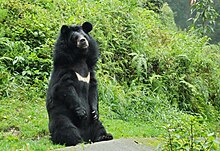| Himalayan black bear | |
|---|---|

| |
| Scientific classification | |
| Domain: | Eukaryota |
| Kingdom: | Animalia |
| Phylum: | Chordata |
| Class: | Mammalia |
| Order: | Carnivora |
| Family: | Ursidae |
| Genus: | Ursus |
| Species: | |
| Subspecies: | U. t. laniger
|
| Trinomial name | |
| Ursus thibetanus laniger Pocock, 1932
| |
| Synonyms | |
| |
The Himalayan black bear (Ursus thibetanus laniger) is a subspecies of the Asian black bear. It is distinguished from U. t. thibetanus by its longer, thicker fur and smaller, whiter chest mark.[4] The species is considered an ecological indicator and a keystone species of the environment.[5] The species plays a vital role as a primary seed disperser in maintaining the stability of the ecosystem.[6] On average, they measure from 56 to 65 inches (140 to 170 cm) nose to tail and weigh from 200 to 265 pounds (91 to 120 kg), though they may weigh as much as 400 pounds (180 kilograms) in the fall, when they are fattening up for hibernation.[7]
The Himalayan black bear is typically nocturnal and elusive, although it has been observed during the day.[8] It hibernates throughout the winter in the northwestern Himalayas, while it is usually active during the entire year in the eastern Himalayas.
- ^ "Hinalayan black bear report" (PDF). ancardchula.gov.np. Archived (PDF) from the original on 2022-07-06. Retrieved 2023-02-10.
- ^ "Bears - WWF-India". wwfindia.org. Archived from the original on 2023-02-08. Retrieved 2023-02-10.
- ^ Pocock, R. I. (1932). "The Black and Brown Bears of Europe and Asia: Part II". The Journal of the Bombay Natural History Society. 36 (1): 115–116. Archived from the original on 2017-08-05. Retrieved 2018-02-21.
- ^ Pocock, R. I. (1941). "The Fauna of British India, including Ceylon and Burma". Mammalia. 2. London: Taylor and Francis.
- ^ Charoo, Samina A.; Sharma, Lalit K.; Sathyakumar, S. (November 2011). "Asiatic black bear–human interactions around Dachigam National Park, Kashmir, India". Ursus. 22 (2): 106–113. doi:10.2192/ursus-d-10-00021.1. ISSN 1537-6176.
- ^ Koike, Shinsuke; Morimoto, Hideto; Kozakai, Chinatsu; Arimoto, Isao; Yamazaki, Koji; Iwaoka, Masahiro; Soga, Masashi; Koganezawa, Masaaki (March 2012). "Seed removal and survival in Asiatic black bear Ursus thibetanus faeces: effect of rodents as secondary seed dispersers". Wildlife Biology. 18 (1): 24–34. doi:10.2981/10-049. ISSN 1903-220X.
- ^ Bears Of The World. "Himalayan Black Bear". Bears Of The World. Archived from the original on 20 March 2015. Retrieved 20 March 2015.
- ^ Zahoor, Babar; Liu, Xuehua; Kumar, Lalit; Dai, Yunchuan; Tripathy, Bismay Ranjan; Songer, Melissa (July 2021). "Projected shifts in the distribution range of Asiatic black bear (Ursus thibetanus) in the Hindu Kush Himalaya due to climate change". Ecological Informatics. 63: 101312. doi:10.1016/j.ecoinf.2021.101312. ISSN 1574-9541. S2CID 235508703.
